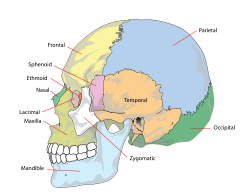|
Temple (anatomy)
The temple, also known as the pterion, is a latch where four skull bones intersect: the frontal, parietal, temporal, and sphenoid.[1] It is located on the side of the head behind the eye between the forehead and the ear. The temporal muscle covers this area and is used during mastication. Cladistics classify land vertebrates based on the presence of an upper hole, a lower hole, both, or neither in the cover of dermal bone that formerly covered the temporalis muscle, whose origin is the temple and whose insertion is the jaw. EtymologyThe word "temple" as used in anatomy has a separate etymology from the other meaning of word temple, meaning "place of worship". Both come from Latin, but the word for the place of worship comes from templum, whereas the word for the part of the head comes from Vulgar Latin *tempula, modified from tempora, plural form ("both temples") of tempus, a word that refers both to "time" and to this part of the head. Due to its shared spelling (but not shared source) with the word for time, the adjective for both is "temporal" (both "pertaining to time" and "pertaining to the anatomical temple"). This reference to time is related to the changes that this region of the head undergoes with the aging process, thus revealing the passage of time. Among these changes are thinning of the skin, the appearance of the first gray hairs, and a greater prominence of the superficial temporal artery, which becomes more visible as an individual ages.[citation needed][inconsistent] The name of the temporalis muscle looks like a form of the Latin word "tempus" meaning "time",[2] but this is a coincidence and the two words do not come from the same root.[3] See also
References
External linksLook up temple in Wiktionary, the free dictionary.
|
||||||||||||||||||||||||||

